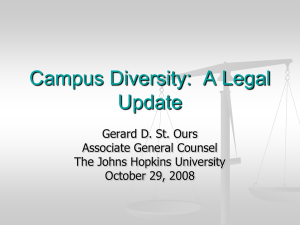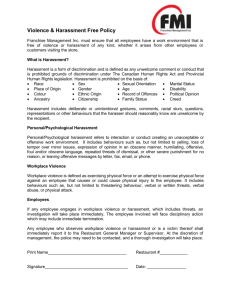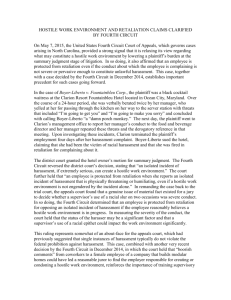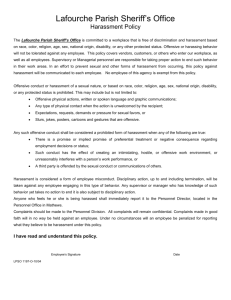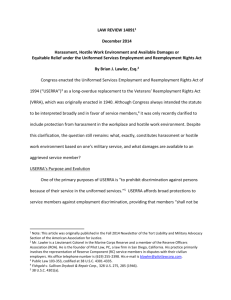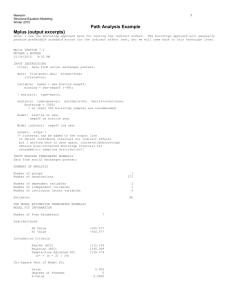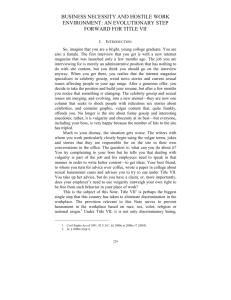When does behavior create a hostile work environment?
advertisement
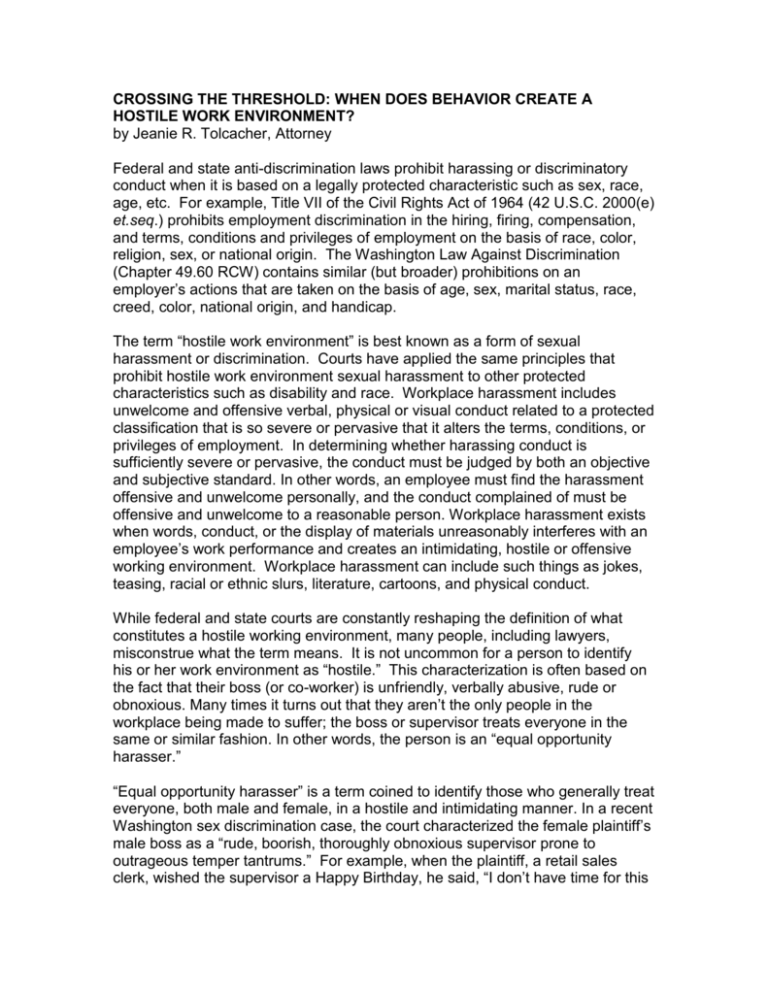
CROSSING THE THRESHOLD: WHEN DOES BEHAVIOR CREATE A HOSTILE WORK ENVIRONMENT? by Jeanie R. Tolcacher, Attorney Federal and state anti-discrimination laws prohibit harassing or discriminatory conduct when it is based on a legally protected characteristic such as sex, race, age, etc. For example, Title VII of the Civil Rights Act of 1964 (42 U.S.C. 2000(e) et.seq.) prohibits employment discrimination in the hiring, firing, compensation, and terms, conditions and privileges of employment on the basis of race, color, religion, sex, or national origin. The Washington Law Against Discrimination (Chapter 49.60 RCW) contains similar (but broader) prohibitions on an employer’s actions that are taken on the basis of age, sex, marital status, race, creed, color, national origin, and handicap. The term “hostile work environment” is best known as a form of sexual harassment or discrimination. Courts have applied the same principles that prohibit hostile work environment sexual harassment to other protected characteristics such as disability and race. Workplace harassment includes unwelcome and offensive verbal, physical or visual conduct related to a protected classification that is so severe or pervasive that it alters the terms, conditions, or privileges of employment. In determining whether harassing conduct is sufficiently severe or pervasive, the conduct must be judged by both an objective and subjective standard. In other words, an employee must find the harassment offensive and unwelcome personally, and the conduct complained of must be offensive and unwelcome to a reasonable person. Workplace harassment exists when words, conduct, or the display of materials unreasonably interferes with an employee’s work performance and creates an intimidating, hostile or offensive working environment. Workplace harassment can include such things as jokes, teasing, racial or ethnic slurs, literature, cartoons, and physical conduct. While federal and state courts are constantly reshaping the definition of what constitutes a hostile working environment, many people, including lawyers, misconstrue what the term means. It is not uncommon for a person to identify his or her work environment as “hostile.” This characterization is often based on the fact that their boss (or co-worker) is unfriendly, verbally abusive, rude or obnoxious. Many times it turns out that they aren’t the only people in the workplace being made to suffer; the boss or supervisor treats everyone in the same or similar fashion. In other words, the person is an “equal opportunity harasser.” “Equal opportunity harasser” is a term coined to identify those who generally treat everyone, both male and female, in a hostile and intimidating manner. In a recent Washington sex discrimination case, the court characterized the female plaintiff’s male boss as a “rude, boorish, thoroughly obnoxious supervisor prone to outrageous temper tantrums.” For example, when the plaintiff, a retail sales clerk, wished the supervisor a Happy Birthday, he said, “I don’t have time for this crap.” There was no evidence, however, that the conduct complained of was directed at the plaintiff because of her sex (or any other protected characteristic). In fact, the employer was able to show that the manager treated both men and women in the same abysmal fashion. While the manager’s behavior was reprehensible, it was not legally actionable and the case was dismissed. This is not an unusual result. Both federal and state courts have routinely dismissed cases such as this because the plaintiff was unable to demonstrate that the harassment is based on a protected characteristic. At what point does an “equal opportunity harasser” cross the threshold between purely obnoxious behavior to behavior that is discriminatory and subject to legal action. While it is well settled that conduct need not be overtly sexual or racial in nature to be actionable, harassing conduct is not illegal unless it is based on sex, race or some other protected characteristic. In addition, with few exceptions, harassment must be pervasive or severe to be actionable. Courts will examine the frequency and severity of the conduct, as well as whether the conduct was physically threatening. Generally speaking, simple teasing, offhand comments and isolated incidents, unless extremely severe, will not amount to discriminatory changes in the terms and conditions of employment. It must be also be kept in mind that a hostile work environment can occur even if the harassment is not targeted at a specific individual (or group of individuals). Environmental harassment can be characterized as harassment other than direct harassment. For example, a hostile work environment may be created for the individual who overhears or witnesses harassing behavior directed at another individual. Even joking behavior or other banter between two individuals or a group of individuals can adversely affect those who may overhear such conversations if the topic relates to a protected characteristic such as sex, religion, or the like. Other examples of environmental harassment would be visual materials such as posters, cartoons, or other literature that denigrates or has the effect of denigrating an individual based on a protected characteristic. The United States Supreme Court has stated that anti-discrimination laws are not meant to be expanded into “codes of civility” in the workplace. Antidiscrimination laws do not generally protect employees from abusive or hostile employers or supervisors. Whether an environment is “hostile” or “abusive” can be determined only by looking at the totality of the circumstances. Equal opportunity harassment, while in some instances not illegal, is still a morale destroyer and can lead to the loss of valuable employees. The employer’s antiharassment policy should prohibit employees from engaging in all forms of inappropriate verbal or physical conduct, not just conduct directed at protected characteristics. All complaints should be taken seriously and thoroughly and promptly investigated. Appropriate discipline should be imposed when necessary. Remember, an ounce of prevention is worth a pound of cure! Jeanie R. Tolcacher is a shareholder in the firm of Lyon, Weigand Gustafson, P.S. in Yakima where she practices in the areas of school law, employment law, and related litigation. She has lectured on school law issues as well as general employment law for a variety of organizations including the University of Washington School Law Academy and the Washington Council of School Attorneys. She can be reached at (509) 248-7220 or at jtolcacher@lyonlaw.com.
